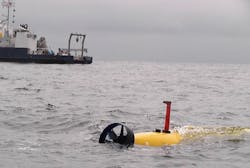Bluefin-21 UUV set this week to make another deep dive in efforts to locate missing Malaysia 370
A modified Bluefin-21 unmanned underwater vehicle (UUV), built by Bluefin Robotics in Quincy, Mass., was scheduled to make another dive this week to locate the missing Malaysia 370, which is presumed to have crashed and submerged somewhere in the Indian Ocean about 1,000 miles west of Australia.
Jeff Smith, chief operating officer of Bluefin Robotics, says his company's Bluefin-21 UUVs has undergone upgrades for deeper dives and is heading to the presumed crash site in the Indian Ocean this week for another attempt to locate the wreckage of Malaysia 370. Smith made his comments at the Association for Unmanned Vehicle Systems International conference and trade show in Orlando, Fla., where the company is exhibiting.
Operating the Bluefin-21 are underwater search experts at Phoenix International Holdings Inc. in Largo, Md., who purchased the Bluefin-21 from Bluefin Robotics for difficult underwater survey missions like the search for Malaysia 370. Phoenix International was the company that located the sunken wreckage of Air France Flight 470 in the Atlantic Ocean in 2011.
Smith says Bluefin Robotics originally received some negative press last month on the Bluefin-21's first dive when the UUV had to surface after reaching its specified depth limit of about 15,000 feet. The ocean floor in the search area is deeper than 15,000 feet, and was out of reach of the Bluefin-21 before the upgrades that enabled it to go deeper.
Bluefin's Smith says research ships with echo-ranging equipment have surveyed the area to get precise readings of the area to get precise depths readings. Until now scientists did not have a precise idea of the actual depths in the Indian Ocean search area, which is extremely remote.
story continues below
With precise depth information in hand, Phoenix International experts were able to dive the Bluefin-21 deeply enough to conduct a thorough search of the area in attempts to locate the missing passenger jet.
Smith says it takes the Bluefin-21 about two hours to dive to depths below 15,000 feet, and another two hours for the UUV to reach the surface after finishing its work. The UUV can remain submerged for about 24 hours, he says, before its battery power begins to run low.
Related: Navy recommends Bluefin 21 underwater drone for next-generation Black Pearl research
The Bluefin-21 has sophisticated imaging sonar equipment that would enable the UUV to detect and identify undersea wreckage from the disappeared Malaysia 370 jumbo jet. The plane reportedly had a black box aboard able to transmit a sonar ping for about a month, but it's unlikely the black box is still able to transmit. The battery that powers its sonar ping likely has been long exhausted.
The Bluefin-21 is a modular autonomous underwater vehicle able to carry several sensors and payloads at once. The UUV is 16.2 feet long, 21 inches in diameter, and weighs 1,650 pounds. It has endurance of 25 hours.
The UUV design includes swappable payload sections and battery modules that allow for in-field maintenance. The craft can be launched and recovered from a simple A-frame or docking head on a variety of surface ships.
The Bluefin-21 uses an inertial navigation system (INS) for navigation, and it has dead reckoning drift typically of less than 0.1 percent of distance traveled, company officials say.
The UUV is designed for applications like offshore survey; search and salvage; archaeology and exploration; oceanography; mine countermeasures; and unexploded ordnance.
Malaysia 370 disappeared from air traffic control screens on 8 March 2014 while en-route from Malaysia to China. The plane has been missing for more than two months.
As of Tuesday afternoon, Bluefin's Smith said he had not received any progress reports from the Bluefin-21's latest dive to locate the missing jetliner.
For more information contact Bluefin Robotics online at www.bluefinrobotics.com.
